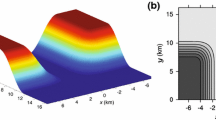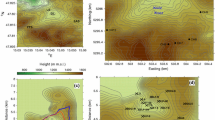Abstract
A numerical model has been used to characterize the development of a region of enhanced cooling in an alpine valley with a width of order \(10\) km, under decoupled stable conditions. The region of enhanced cooling develops largely as a region of relatively dry air which partitions the valley atmosphere dynamics into two volumes, with airflow partially trapped within the valley by a developing elevated inversion. Complex interactions between the region of enhanced cooling and the downslope flows are quantified. The cooling within the region of enhanced cooling and the elevated inversion is almost equally partitioned between radiative and dynamic effects. By the end of the simulation, the different valley atmospheric regions approach a state of thermal equilibrium with one another, though this cannot be said of the valley atmosphere and its external environment.









Similar content being viewed by others
References
Acevedo OC, Fitzjarrald DR (2001) The early evening surface-layer transition: temporal and spatial variability. J Atmos Sci 58:2650–2667
Anquetin S, Guilbaud C, Chollet JP (1999) Thermal valley inversion impact on the dispersion of a passive pollutant in a complex mountainous area. Atmos Environ 33:3953–3959
Baines PG (2008) Mixing in downslope flows in the ocean plumes versus gravity currents. Atmosphere-Ocean 46:405–419
Blyth S, Groombridge B, Lysenko I, Miles L, Newton A (2002) Mountain Watch: environmental change and sustainable development in mountains. Report, UNEP World Conservation Monitoring Centre, Cambridge, 80 pp
Brulfert C, Chemel C, Chaxel E, Chollet JP (2005) Modelling photochemistry in alpine valleys. Atmos Chem Phys 5:2341–2355
Burns P, Chemel C (2014) Evolution of cold-air-pooling processes in complex terrain. Boundary-Layer Meteorol 150:423–447
Catalano F, Cenedese A (2010) High-resolution numerical modeling of thermally driven slope winds in a valley with strong capping. J Appl Meteorol Climatol 49:1859–1880
Chazette P, Couvert P, Randriamiarisoa H, Sanak J, Bonsang B, Moral P, Berthier S, Salanave S, Toussaint F (2005) Three-dimensional survey of pollution during winter in French Alps valleys. Atmos Environ 39:1035–1047
Chemel C, Burns P (2013) Pollutant dispersion in a developing valley cold-air pool. Boundary-Layer Meteorol (under review)
Chen F, Dudhia J (2001) Coupling an advanced land-surface/hydrology model with the Penn State/NCAR MM5 modeling system. Part I: model implementation and sensitivity. Mon Weather Rev 129:569–585
Daly C, Conklin DR, Unsworth MH (2010) Local atmospheric decoupling in complex topography alters climate change impacts. Int J Climatol 30:1857–1864
Deardorff JW (1980) Stratocumulus-capped mixed layers derived from a three-dimensional model. Boundary-Layer Meteorol 18:495–527
Dudhia J (1989) Numerical study of convection observed during the winter monsoon experiment using a mesoscale two-dimensional model. J Atmos Sci 46:3077–3107
Dudhia J (1995) Reply. Mon Weather Rev 123:2573–2575
Gustavsson T, Karlsson M, Bogren J, Lindqvist S (1998) Development of temperature patterns during clear nights. J Appl Meteorol 37:559–571
Hoch SW, Whiteman DC, Mayer B (2011) A systematic study of longwave radiative heating and cooling within valleys and basins using a three-dimensional radiative transfer model. J Appl Meteorol Climatol 50:2473–2489
Iacono MJ, Delamere JS, Mlawer EJ, Shephard MW, Clough SA, Collins WD (2008) Radiative forcing by long-lived greenhouse gases: calculations with the AER radiative transfer models. J Geophys Res 113:D13,103. doi:10.1029/2008JD009944
Jiménez PA, Dudhia J, Gonzalez-Rouco JF, Navarro J, Montávez JP, García-Bustamante E (2012) A revised scheme for the WRF surface layer formulation. Mon Weather Rev 140:898–918
Klemp JB, Dudhia J, Hassiotis AD (2008) An upper gravity-wave absorbing layer for NWP applications. Mon Weather Rev 136:3987–4004
Mahrt L (1982) Momentum balance of gravity flows. J Atmos Sci 39:2701–2711
Mahrt L (2014) Stably stratified atmospheric boundary layers. Annu Rev Fluid Mech. doi:10.1146/annurev-fluid-010313-141354
Mahrt L, Vickers D, Nakamura R, Soler MR, Sun JL, Burns S, Lenschow DH (2001) Shallow drainage flows. Boundary-Layer Meteorol 101:243–260
Mansell ER, Ziegler CL, Bruning EC (2010) Simulated electrification of a small thunderstorm with two-moment bulk microphysics. J Atmos Sci 67:171–194
Maybeck M, Green P, Vorosmarty C (2001) A new typology for mountains and other relief classes: an application to global continental water resources and population distribution. Mountain Res Dev 21:34–45
McNider RT (1982) A note on velocity fluctuations in drainage flows. J Atmos Sci 39:1658–1660
Moeng CH, Dudhia J, Klemp J, Sullivan P (2007) Examining two-way grid nesting for large eddy simulation of the PBL using the WRF model. Mon Weather Rev 135:2295–2311
Nachabe MH (1998) Refining the definition of field capacity in the literature. J Irrig Drain Eng 124:230–232
Nadeau DF, Pardyjak ER, Higgins CW, Huwald H, Parlange MB (2012) Flow during the evening transition over steep Alpine slopes. Q J R Meteorol Soc. doi:10.1002/qj.1985
Neff WD, King CW (1989) The accumulation and pooling of drainage flows in a large basin. J Appl Meteorol 28:518–529
Noppel H, Fiedler F (2002) Mesoscale heat transport over complex terrain by slope winds—a conceptual model and numerical simulations. Boundary-Layer Meteorol 104:73–97
Oke TR (1987) Boundary layer climates. Routledge, London 464 pp
Price JD, Vosper S, Brown A, Ross A, Clark P, Davies F, Horlacher V, Claxton B, McGregor JR, Hoare JS, Jemmett-Smith B, Sheridan P (2011) COLPEX: field and numerical studies over a region of small hills. Bull Am Meteorol Soc 92:1636–1650
Scotti A, Meneveau C, Lilly DK (1993) Generalized Smagorinsky model for anisotropic grids. Phys Fluids 5:2306–2308
Shu CW (2003) High-order finite difference and finite volume WENO schemes and discontinuous Galerkin methods for CFD. Int J Comput Fluid Dyn 17:107–118
Skamarock WC, Klemp JB, Dudhia J, Gill DO, Barker DM, Duda MG, Huang XY, Wang W, Powers JG (2008) A description of the advanced research WRF Version 3. NCAR Technical Note NCAR/TN-475+STR, NCAR, Boulder, 125 pp
Szintai B, Kaufmann P, Rotach MW (2010) Simulation of pollutant transport in complex terrain with a numerical weather prediction-particle dispersion model combination. Boundary-Layer Meteorol 137:373–396
Vergeiner I, Dreiseitl E (1987) Valley winds and slope winds—observations and elementary thoughts. Meteorol Atmos Phys 36:264–286
Vinokur M (1980) On one-dimensional stretching functions for finite-difference calculations. NASA Contractor Report 3313, NASA, Washington, 56 pp
Whiteman CD (2000) Mountain meteorology: fundamentals and applications. Oxford University Press, New York 355 pp
Zardi D, Whiteman CD (2013) Diurnal mountain wind systems. In: Chow FK, De Wekker SFJ, Snyder BJ (eds) Mountain weather research and forecasting: recent progress and current challenges, chap 2. Springer Atmospheric Sciences, Springer, New York, pp 35–119
Author information
Authors and Affiliations
Corresponding author
Rights and permissions
About this article
Cite this article
Burns, P., Chemel, C. Interactions Between Downslope Flows and a Developing Cold-Air Pool. Boundary-Layer Meteorol 154, 57–80 (2015). https://doi.org/10.1007/s10546-014-9958-7
Received:
Accepted:
Published:
Issue Date:
DOI: https://doi.org/10.1007/s10546-014-9958-7




